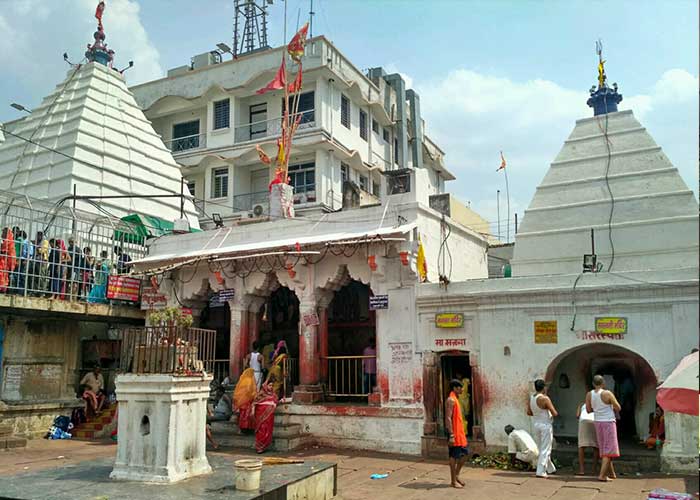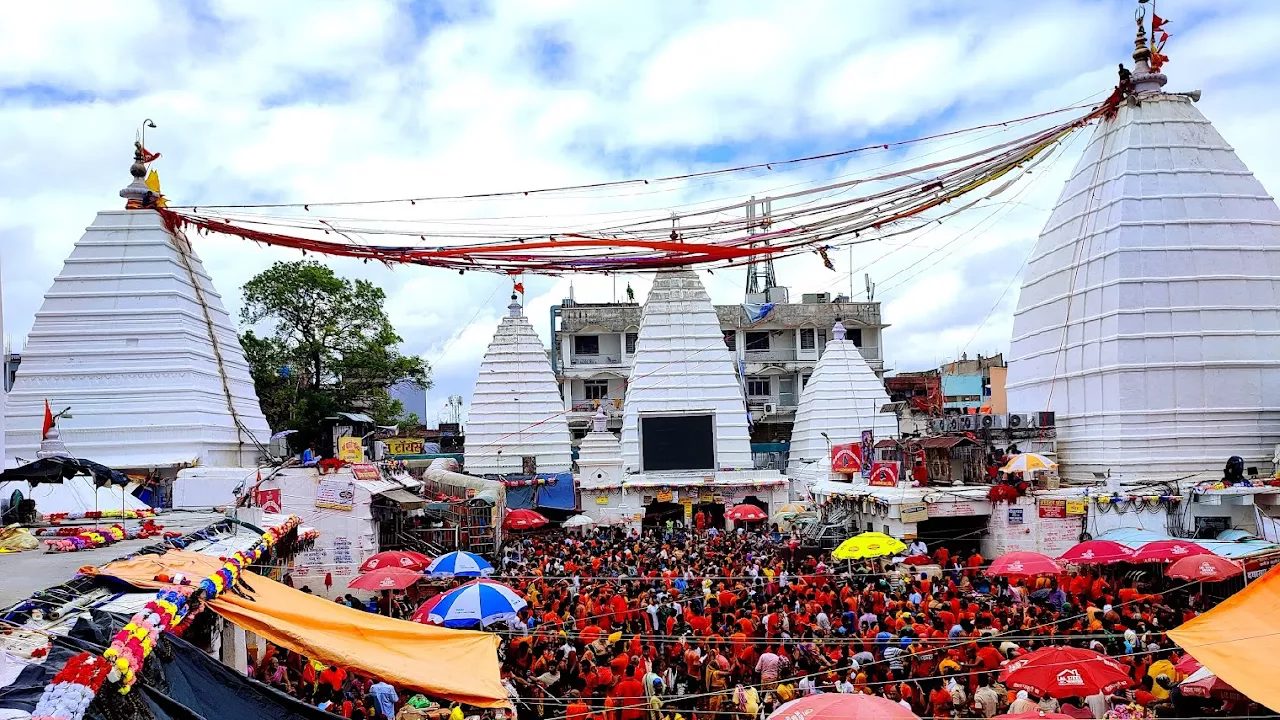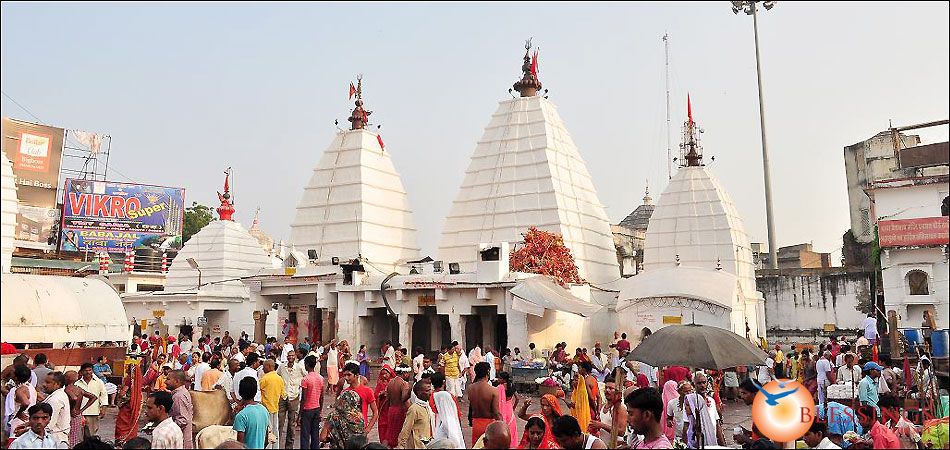The Baidyanath Temple, also known as Vaidyanath Temple or Baidyanath Dham, is one of the most sacred Hindu temples located in Deoghar, in the state of Jharkhand, India. It is dedicated to Lord Shiva, specifically to his manifestation as Vaidyanath, the “Lord of Physicians.” This temple is considered one of the twelve Jyotirlingas (sacred shrines of Lord Shiva), making it an important pilgrimage site for devotees of Lord Shiva.
The main lingam (an abstract representation of Lord Shiva) at Baidyanath Temple is believed to have self-manifested, and it is said to have great healing powers. The temple complex is spread over a large area and consists of several other smaller temples and shrines. It attracts a large number of devotees, particularly during the Hindu month of Shravan, which is considered highly auspicious for worshiping Lord Shiva. During this time, many pilgrims undertake a journey to the temple, often on foot, carrying holy water from the Ganges River to offer to the deity.
The Baidyanath Temple is not only a place of worship but also an architectural marvel with intricate designs and carvings. The temple’s management and administration are handled by the Deoghar Mahagovinda Trust. The temple and the town of Deoghar have a rich history and cultural significance for Hindus and attract visitors and devotees from all over India.
Table of Content
History
The Baidyanath Temple, also known as Vaidyanath Jyotirlinga, is one of the twelve Jyotirlingas, which are sacred shrines dedicated to Lord Shiva in Hinduism. It is located in the Deoghar district of the state of Jharkhand, India. The history of the Baidyanath Temple is deeply rooted in Hindu mythology and has a significant cultural and religious significance.
-
Mythological Origin: According to Hindu mythology, the Baidyanath Temple is associated with the legend of Ravana, the demon king of Lanka. It is said that Ravana was a great devotee of Lord Shiva and performed rigorous penance to please him. To make his devotion even more powerful, he wanted to bring a Jyotirlinga, a symbol of Lord Shiva, to Lanka. However, Lord Shiva tricked Ravana and manifested himself as a young boy. He placed the Jyotirlinga on the ground at Deoghar, and it became fixed there, becoming known as the Vaidyanath Jyotirlinga.
-
Historical Significance: The Baidyanath Temple is considered one of the most sacred pilgrimage sites for Hindus, and it has a long history of worship and reverence. The temple complex has seen various renovations and additions over the centuries. The current temple structure is believed to have been rebuilt during the 18th century.
-
Architecture: The temple is known for its intricate architectural style and stands as a fine example of North Indian temple architecture. It features a courtyard with a spire that rises high above, and it is adorned with various sculptures and carvings.
-
Religious Importance: Devotees from all over India and beyond visit the Baidyanath Temple to seek the blessings of Lord Shiva. It is especially significant during the holy month of Shravan (usually in July-August) when thousands of pilgrims undertake the Kanwar Yatra, a pilgrimage where they carry holy water from the Ganges River to offer to Lord Shiva at the temple.
-
Festivals: The temple celebrates various festivals with great enthusiasm, including Maha Shivaratri, Shravani Mela, and other religious events, attracting large crowds of devotees.
-
Maintenance and Management: The Baidyanath Temple is maintained and managed by the Deoghar Municipal Corporation and the Jharkhand government, ensuring that the temple premises are well-maintained and accessible to devotees.
The Baidyanath Temple is not only a religious and spiritual center but also a symbol of the rich cultural and historical heritage of the region. It continues to be a place of deep reverence and devotion for millions of people who visit it to seek the blessings of Lord Shiva.
Yearly Festivals
The Baidyanath Temple, also known as Vaidyanath Jyotirlinga Temple, is one of the 12 Jyotirlingas, which are considered sacred shrines of Lord Shiva in Hinduism. Located in Deoghar, Jharkhand, India, this temple is a significant pilgrimage site for Shiva devotees. While the temple is open throughout the year, there are specific festivals and special occasions when devotees flock to the temple to offer their prayers and seek blessings. Some of the annual festivals and special occasions celebrated at the Baidyanath Temple include:
-
Shravani Mela: This is one of the most famous festivals at Baidyanath Temple and typically occurs during the Hindu month of Shravan, which usually falls in July or August. During this time, devotees, known as Kanwariyas, carry holy water from the Ganges River and offer it to Lord Shiva at the temple. The temple witnesses a massive influx of pilgrims during this period.
-
Maha Shivaratri: This is a significant festival dedicated to Lord Shiva and is celebrated with great enthusiasm at the Baidyanath Temple. Devotees fast and offer special prayers on this day, which usually falls in February or March.
-
Kartik Purnima: Celebrated on the full moon day in the Hindu month of Kartik (usually in November), this festival is marked by special rituals and aarti dedicated to Lord Shiva.
-
Sawan Mela: Apart from Shravani Mela, there are also smaller Sawan Melas held during different days of the Shravan month, where devotees come to offer prayers and seek blessings.
-
Makar Sankranti: This festival, marking the transition of the sun into the zodiac sign of Capricorn, is celebrated in January. Devotees take holy dips in the sacred river and visit the Baidyanath Temple during this time.
-
Pitru Paksha: Pitru Paksha is a period dedicated to honoring one’s ancestors. It is a time when people perform rituals to pay homage to their deceased forebears. The temple sees increased activity during this time.
-
Navaratri: The nine-day festival of Navaratri, dedicated to the goddess Durga, is also celebrated with fervor at the Baidyanath Temple. Devotees come to seek blessings from the divine mother during this time.
-
Diwali: The festival of lights, Diwali, is celebrated with traditional fervor and enthusiasm at the temple. Special pujas and aarti are performed, and the temple is adorned with lamps and decorations.
These are some of the annual festivals and special occasions celebrated at the Baidyanath Temple. The temple also sees daily rituals and pujas conducted throughout the year to honor Lord Shiva. Please note that the exact dates of these festivals may vary each year, as they are based on the Hindu lunar calendar. It’s advisable to check the specific dates with the temple authorities or a reliable Hindu calendar.
Daily Pujas
The Baidyanath Temple, also known as Vaidyanath Temple or Baidyanath Dham, is one of the 12 Jyotirlingas, which are considered the most sacred temples dedicated to Lord Shiva. It is located in Deoghar in the state of Jharkhand, India. The temple complex is a significant pilgrimage site for Hindus and sees a large number of devotees from all over the country. The daily pujas and rituals at the Baidyanath Temple are performed with great devotion and adherence to tradition.
The daily pujas at Baidyanath Temple typically include the following:
-
Mangala Aarti: The first aarti of the day is performed early in the morning, usually before sunrise, to wake up the deity and seek blessings.
-
Abhishek: This is the ceremonial bathing of the Shiva Linga with various offerings, such as milk, water, honey, ghee, yogurt, and more.
-
Shringar Puja: After the Abhishek, the deity is adorned with fine clothes, jewelry, and flowers.
-
Naivedyam: Offerings of food and sweets are made to Lord Shiva, and these are later distributed as prasad to the devotees.
-
Madhyan Aarti: This aarti is performed in the afternoon to seek the blessings of Lord Shiva.
-
Bhog: Another offering of food to the deity is made in the afternoon.
-
Dhoop Aarti: The evening aarti is performed to illuminate the temple and offer prayers.
-
Sheja Aarti: This is the last aarti of the day, performed before the deity is put to rest for the night.
-
Ratri Aarti: A special aarti is performed during the night to conclude the day’s rituals.
Apart from these daily pujas, the temple also hosts various special pujas and festivals throughout the year, especially during the Shravan month (July-August), which is considered extremely auspicious for Lord Shiva. Thousands of devotees visit the Baidyanath Temple during this time to participate in the special rituals.
Please note that the exact timing and details of the pujas may vary, and it’s a good idea to check with the temple authorities or local priests for the most current information if you plan to visit the Baidyanath Temple for worship.
How To Reach
The Baidyanath Temple, also known as Vaidyanath Jyotirlinga Temple, is one of the twelve Jyotirlingas, which are sacred shrines dedicated to the Hindu god Shiva. It is located in Deoghar, Jharkhand, India. To reach the Baidyanath Temple, you can follow these general directions:
-
By Air: The nearest airport to Deoghar is the Dumka Airport, which is approximately 66 kilometers away. However, it has limited connectivity. The nearest major airport is the Birsa Munda Airport in Ranchi, which is approximately 266 kilometers from Deoghar. From Ranchi, you can hire a taxi or take a bus to reach Deoghar.
-
By Train: Deoghar has its own railway station, Deoghar Railway Station, which is well-connected to major cities in India. You can check the train schedule and book tickets to Deoghar. The temple is approximately 7 kilometers from the railway station.
-
By Road: Deoghar is well-connected by road to major cities and towns in Jharkhand and neighboring states. You can either hire a taxi or take a bus to reach Deoghar. The temple is situated in the heart of the town, so you can easily find transportation to the temple from the bus stand or railway station.
-
Local Transportation: Once you reach Deoghar, you can use local transportation options such as auto-rickshaws, cycle rickshaws, or taxis to reach the Baidyanath Temple. The temple is located in the main market area, so it’s easily accessible.
Remember to check the current transportation options and schedules as they may change over time. Additionally, it’s a good idea to inquire about any specific rituals or procedures for visiting the temple, as different temples may have their own customs and rules.
Where To Stay
Baidyanath Temple, also known as Vaidyanath Jyotirlinga Temple or Baba Baidyanath Dham, is one of the twelve Jyotirlingas, which are sacred shrines dedicated to Lord Shiva. This temple is located in Deoghar, Jharkhand, India. When visiting the Baidyanath Temple, you can consider staying in the vicinity of Deoghar. Here are some accommodation options:
-
Baidyanath Temple Guesthouses: The temple authority often provides guesthouses for pilgrims. These guesthouses are simple but convenient options for staying close to the temple.
-
Hotels and Lodges: Deoghar has a range of hotels and lodges to suit different budgets. Some popular hotels in the area include Hotel Yashoda International, Hotel Sangam, and Hotel Rajkamal.
-
Dharamshalas: There are also Dharamshalas (religious guesthouses) in the area that provide affordable accommodation for pilgrims. Some well-known Dharamshalas include Rikhiapeeth Dharamshala and Shyama Charan Devi Dharamshala.
-
Online Booking: You can use various hotel booking websites or apps to find and book accommodations that match your preferences. Booking in advance is often a good idea, especially during the peak pilgrimage seasons.
-
Private Guesthouses: Some locals may offer guesthouses or rooms for rent. You can inquire locally or use online platforms like Airbnb to find such options.
Remember to plan your stay in advance, particularly during the peak pilgrimage season, and consider the proximity to the temple if that is an essential factor for your visit. Additionally, it’s a good idea to check reviews and ratings of accommodations to ensure a comfortable stay during your visit to Baidyanath Temple.




